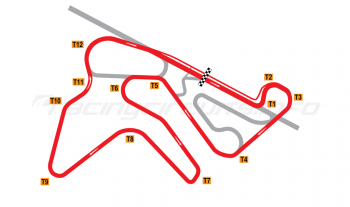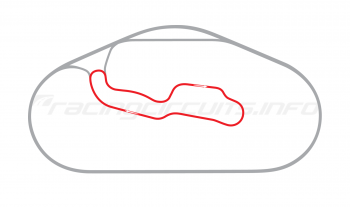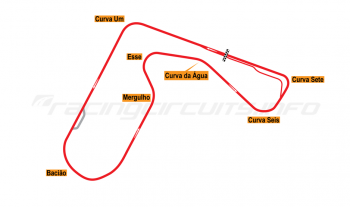Stardust International Raceway
Circuit Overview
Stardust International Raceway burned brightly in the Nevada desert sun for just six short years, attracting top international stars and cars of the day, before succumbing to the developer’s bulldozer. Names like Dan Gurney, Mario Andretti, Parnelli Jones, A.J. Foyt and the Unser brothers, Al and Bobby, all competed here, along with international interlopers such as Jackie Stewart, John Surtees, Bruce McLaren and Denis Hulme.
Home to the Can-Am Championship, Trans-Am and the USAC Champ Cars as well as drag racing events, it had a brief and varied history before closing and eventually disappearing as the urban expansion of the desert city swallowed it whole.
Like many things in Vegas, however, dig beneath the surface and a shady world of dirty money and mobster connections soon reveals itself. Everything was not quite as it seemed and the circuit’s backers had more than their fair share of alleged links to organised crime.
Circuit History
It’s hard to believe today, but when the circuit was first constructed in 1965, it sat out in the dusty desert, miles from any of the urban sprawl that was to become the hallmark of the area in later years. It was created by Moe Dalitz, the legendary bootlegger and racketeer behind the Desert Inn and the Stardust casino (hence the track’s name), ostensibly in a bid to provide another sporting activity to help drive high rollers to casinos of the Strip.
Or at least, that was the public facade. In reality, as Randall Cannon and Michael Gerry lay out in their comprehensive tome Stardust International Raceway: Motorsports Meets The Mob In Vegas, 1965-1971, the track was a useful tool in a complex web of money laundering and racketeering by organised crime groups. Just as the Stardust casino was synonymous with a massive “skim” of profits that went to Midwestern mobsters, it seems highly probable that the track was similarly a front for washing dirty money.
As Cannon told Nevada Public Radio: “The racetrack itself was generally a cash business and there probably was a lot of untaxed cash that went through that place but more so I think the property was used almost like a ‘bearer share’ type of system. In the time period there were a number of very large pieces of property that were owned by organised crime elements or people who fronted for organised crime. I think Stardust International Raceway was effectively one of those properties.
“Whereas a mobster couldn’t own public shares, couldn’t be on the gambling license of the Stardust or the Desert Inn, they might own a stake in a piece of property and that would effectively become the ledger mechanism through which they would otherwise commit their casino business.”
A frequently told story about the origins of the track is that it was born during a conversation at the Sebring 12 Hours in early 1965, when New Yorker Harold Jason, a business associate of Dalitz, discussed the feasibility of bringing road racing to Las Vegas. Evidently, Moss thought the prospect eminently viable and in quick order the plans began to be penned. The only slight difficulty with this story is that the Stardust Racing Association was actually formed two weeks prior to the Sebring race, so it seems highly implausible that this was the true beginning of the story.
How the circuit really began
As is common in the history of much of Las Vegas, the truth about the real origins of the project is far harder to discern. What is known is that the entity which actually purchased the property from its original gravel-claim owners was a newly incorporated firm called Rainbow Acres Inc., whose president was Merv Adelson and Vice President was Irwin Molasky. The pair would go on to be major players in the development of Las Vegas along with Dalitz, responsible for building the Las Vegas Country Club as well as what became Sunrise Hospital and Medical Center.
In 1965, ownership of the lot was transferred to the Stardust Racing Association, with Dalitz as president and the manager of the Stardust hotel and casino, Allard Roen (later convicted for fraud), as Vice President. The somewhat mysterious Harold Jason, about whom very little is known, was also a partner.
Development ensued very swiftly thereafter, with a three-mile road course incorporating a drag strip being constructed. All told, construction crews moved some 190,000 cubic yards of earth, before paving the course with 9,000 tons of asphalt.
With the Las Vegas racing scene remaining somewhat limited, track manager Leo Margolian was encouraged by the SCCA to look elsewhere for expertise to run racing events, suggesting that the Californian Sports Car Club - better known as Cal Club - would be a good pairing. A deal was made with Cal Club’s Chic Vandergriff, which would see the club awarded a five year contract to put on all sports car races at the new facility.
Cal Club members also leant their expertise as construction began, with Vandergriff regularly on site to assist with the grading and profiling of the corners, along with other prominent drivers on the sports racing scene. There were some modifications to the layout during this process; originally, the left-hander at Turn 2 featured a dip, but the driver advisors expressed unease with this and the dip was eliminated. A slight ripple on the corner exit was generated by the re-profiling, causing many subsequent tail-out moments as a result.
The new facility was officially declared open on September 21, 1965, with a ribbon-cutting ceremony on the front stretch in front of local media. In attendance were members of Carrol Shelby’s Cobra Racing team, complete with three Shelby-prepared cars; a GT40, Shelby Cobra and GT350, accompanied by a Ferrari 250. Ken Miles took Moe Dalitz on a ride around the track in the GT40, while other notable faces said to be at the event were Parnelli Jones and Jim Clark. Allard Roen and Harold Jason were also pictured, with Jason perched prominently on the driver’s side of the GT40.
First event showcases the course
An inaugural race was organised by the Cal Club on October 3-4, 1965, though at this stage the track was in a very unfinished state, with no grandstands or any other facilities to speak of. Separation between the speeding cars and spectators was perhaps best described as haphazard, with no guardrails along the pit straight, no retaining wall between the racing area and pit lane and simple chain-link fencing around what purported to be spectator areas.
Despite these shortcomings, the event nevertheless passed without incident. It was more about trialing the event organisation capabilities than it was about attracting a crowd. Indeed, there was no advance publicity and it was in reality a racers-only event for regional club members in assorted machinery. Jerry Entin had the honour of taking out the very first heat win in his Chevrolet-powered Cheetah. Along the way to a dominant victory, he also set the fastest lap, becoming the only driver to lap the course below two minutes lap across the weekend.
He had to work harder in the Sunday feature after a bad start, eventually catching long-time leader Norm Smith in a Porsche 904 on the last lap. The pair clashed in the braking zone for the final left-hander and went off into the gravel. It was Entin who recovered fastest, rejoining the course and crossing the line for the historic overall victory.
Of course, this was just the beginning of the circuit’s first chapter and there was still much to do before it was properly ready for its first public event, the Stardust Grand Prix on November 12-14, 1965. In just six weeks trackside barriers, a concrete pit wall and temporary grandstands were fitted to bring a modicum of civility to proceedings for all concerned.
There was little doubt that the race would attract a decent entry from the world of sportscar racing, held as the final round of the Autoweek Championships. The prize purse took care of that; what was initially reported as a $30,000 total fund was soon upped, with the winner guaranteed to take $8000 alone. Of course, this being Vegas, the source of the funding was more than a little opaque but that hardly mattered to the racers, who were set to take home the biggest ever winnings in Las Vegas motorsport history.
Headlining the bill were the Chaparral cars of Jim Hall and Hap Sharp, with John Mecom entering Parnelli Jones and Walt Hansgen in Lola T-70s. Similar cars were entered by others for Bob Bondurant and Ronnie Bucknam, while George Follmer had a Lotus 23 at his disposal. Other notables in the field were Augie Pabst in the lone Scarab, Jerry Titus in an Elva-Porsche and a returning Jerry Entin, this time entered in a McLaren.
At the start Parnelli Jones led away through the first turn from the rolling start, pursued by Jerry Grant in a Chevrolet-powered Lotus 19. He took the lead after five laps but could only last three tours up front before a transaxle failed, putting him out on the spot. Charlie Hayes then took over in front in his McLaren Elva Mark I Oldsmobile until the engine blew after just one lap.
Through the mechanical carnage sailed Jim Hall and Hap Sharp, the pair circulating at the head of the field for the next hour. However, on lap 63 of 65, Hall’s engine stuttered and he coasted to the pits needing a quick refuel. Sharp flew by and onto victory ahead of Walt Hansgen. A disappointed Hall was able to rejoin and salvage a third place finish.
A surprised Sharp confessed to not knowing he had won until someone thrust a microphone in his direction and offered congratulations. As Sharp stood in the cockpit he was greeted by Margaret White, a Stardust showgirl who had been declared the ‘race queen’ in the run up to the event, featuring heavily in the promotional activity. Out in the stands, a delighted Moe Dalitz was apparently watching on, having walked the six miles out to the track to watch events without drawing attention to himself.
Can-Am thunder arrives
The following year, Stardust Raceway would bookend the season with two high-profile sportscar events; the season-opening race of the SCCA United States Road Racing Championship on April 24 and the season-closing round of the legendary Can-Am Challenge for Group 7 sportscars, which had morphed from the Autoweek Championships.
The first of these events was notable for the entrant of the winning car; actor Dan Blocker (best known for his portrayal of Hoss Cartwright in the long-running NBC television series, Bonanza). His Genie Mk.10 Chevrolet propelled John Cannon to victory ahead of the similar car of Chuck Parsons.
The Can-Am season closer was also a title decider, with an impressive seven drivers still in contention going into the race. Come the drop of the flag, however, Englishman John Surtees made short work of bagging the championship trophy, vaulting from fourth place on the starting grid to the lead by the first corner. From there he stayed up front for the remaining 210 miles, heading home Bruce McLaren and Mark Donohue for the win.
The 1967 season featured an expanded roster of races, with Trans-Am making what would turn out to be a one-off appearance alongside the USRRC and Can-Am events. Mark Donohue took victory for Roger Penske in a Chevrolet Camaro.
The Can-Am race was again a title decider, between Bruce McLaren and his team mate Denny Hulme. The season had proved the Bruce and Denny show as they dominated in their McLaren M6A Chevrolets. It was not to be in the season finale, however; Bruce won pole but blew an engine early in the race, handing the advantage to Denny. He too though experienced engine issues throughout the weekend and coasted to a halt, leaving his boss as the champion. The dramas all allowed outgoing champion John Surtees to take his only win of the year in a Lola T70 Chevrolet.
USAC stars arrive just as racing fades out
The 1968 season would prove to be both the highpoint for Stardust International Raceway and the beginning of the end. The calendar opened with a new event, the Stardust 150, held as round two of the USAC Championship Car season on March 31. It came as USAC began to expand its horizons and diversify its calendar, including road course races alongside ovals. As a state-of-the-art facility (for the day) , Stardust met the bill and so it was that the likes of the Unser brothers, Mario Andretti, A.J. Foyt, Dan Gurney, Gordon Johncock et al arrived.
Prior to the race, the only alteration to the Stardust course was carried out, when the esses between Turns 4 and 5 were eased slightly, though otherwise the course was as originally built. When the action commenced,
Dan Gurney took the pole in his Eagle but in the race he lost the lead to Bobby Unser and was a lap one sprint-out when he caught gravel thrown up by the leader. The race panned out to a duel between Unser and Mario Andretti until Andretti ran short on fuel and had to pit and chase from behind. Unser eked his fuel to perfection - running out just after the checkered flag.
Much like Andretti’s race, behind the scenes, the story of the raceway was beginning to unravel. In March, the Stardust Racing Association was abruptly dissolved and the circuit ownership was transferred to Karat, Inc. - the gambling operator of the Stardust Hotel. Into the mix comes the infamous Howard Hughes, who made an offer to buy the hotel, casino and racetrack, though this was rebuffed by Dalitz.
The racing calendar continued through 1968 to the season finale of the Can-Am Challenge, again with the title still undecided. Bruce McLaren, Mario Andretti and Jim Hall were involved in a first-lap melee, which took care of Chris Amon’s Ferrari when dust clogged up the intake valves.
The others were able to resume racing but it was the other McLaren of Denny Hulme which took the win and the championship, avenging his loss from the year before. Sadly, the victory was overshadowed when the recovering Hall was caught out on the backstretch by the suddenly slowing car of Lothar Motschenbacher. His Chaparral reared up over the back of Motschenbacher’s Leader Cards-entered McLaren, launching it skyward. The car split in two on landing, leaving Hall with horrific leg injuries which ultimately would end his driving career.
One final amateur race event - an SCCA national and regional sports car meeting - took place in February 1969, after which the track fell silent. IT would never again host racing, though drag events would continue for a few seasons more.
Track closure announced
Following a flooding of the facility when the nearby Flamingo Wash river overflowed, on 22 March1969 the track’s permanent closure was announced. Supposedly, the circuit had failed to attract the right level of spectators for it to remain viable and the flooding had been the final straw. However, it is likely that the real reason was the value of the land itself; with the Vegas urban sprawl encroaching ever nearer and at fast pace, it was never likely that the circuit could survive in the longer term.
Dalitz by this stage had transferred the track ownership to the Stardust Hotel which in turn then sold it on to the Parvin-Dohrmann Corporation. The deal turned out to be less than fully transparent; lawyer Sidney Korshak (representing the Stardust Hotel) took a half-million dollar fee from the sale which was not disclosed to the Parvin-Dohrmann shareholders. Korshak was notorious as a lawyer and ‘fixer’ for Chicago organised crime groups, including Al Capone and Jimmy Hoffa…
Parvin-Dohrmann had little interest in motorsport, so in 1970 the circuit and land were transferred once again to Pardee Homes, which was developing the major urban housing expansion that would become Spring Valley. It would take some time before the urban sprawl would catch up to the raceway, however, so Pardee was happy to lease the facility out to track manager Larry Horton to continue drag racing events. The last major event was therefore the NHRA Stardust National Open, which took place in February 1971. By then the facilities were starting to look a little careworn, as the sound of the developers bulldozers edged ever closer. A further local drag event occurred in October 1971, after which Stardust International Raceway was no more. By the end of the decade, all trace of it had been wiped from the landscape.
Jump onboard
Circuit info
This is a historic circuit which is no longer in operation.
Rate This Circuit
Votes: 349
Location Information
Much like the iconic hotel and casino which gave it its name, there is very little remaining to suggest that Stardust International Raceway ever existed. Today, the area where the track once stood is a fully-developed part of the Spring Valley neighbourhood, contained within the parcel of land bordered by West Flamingo Road, South Rainbow Boulevard, West Tropicana Avenue, and South Buffalo Drive. Head south down New Forest Drive to the junction with Salishan Drive and you will be roughly where the start/finish area, pits and paddock once stood, though it’s doubtful that any of the current residents have any idea of their area’s prior history!
Get your race tickets!
Brought to you with: 
We've teamed up with Motorsports Tickets to bring you the best deals for Formula One, MotoGP, Le Mans and more.









